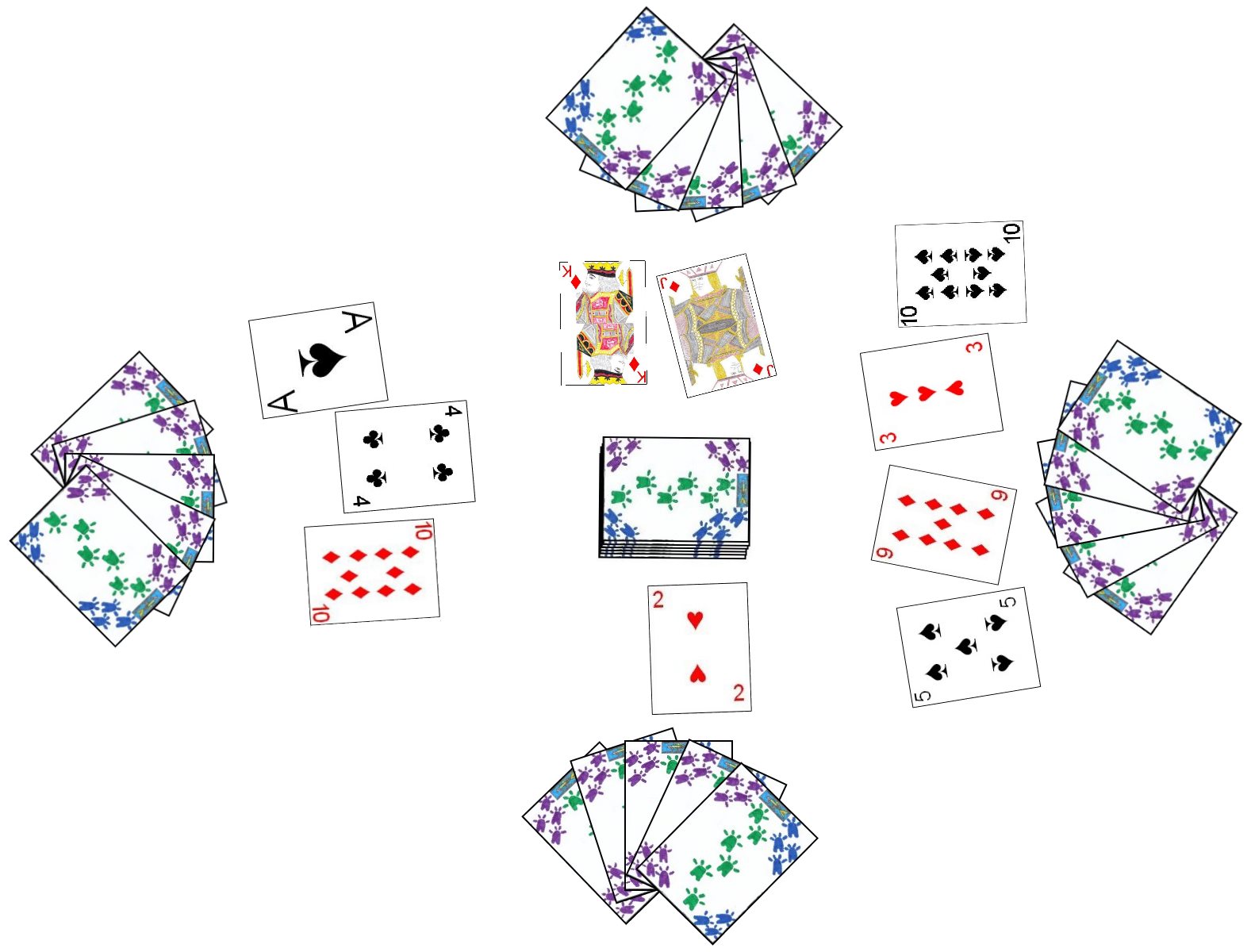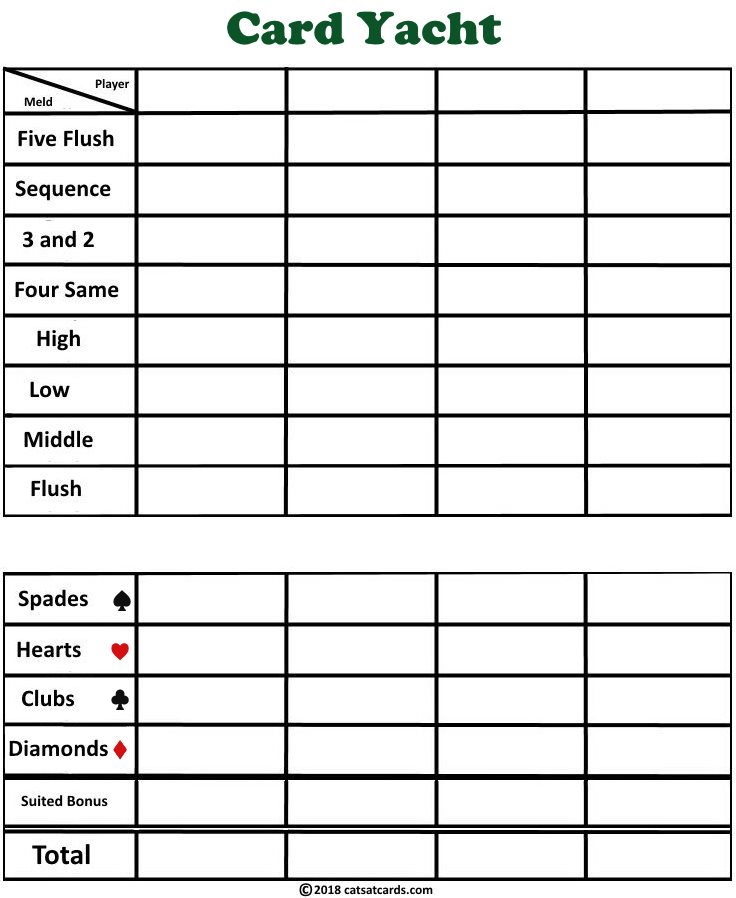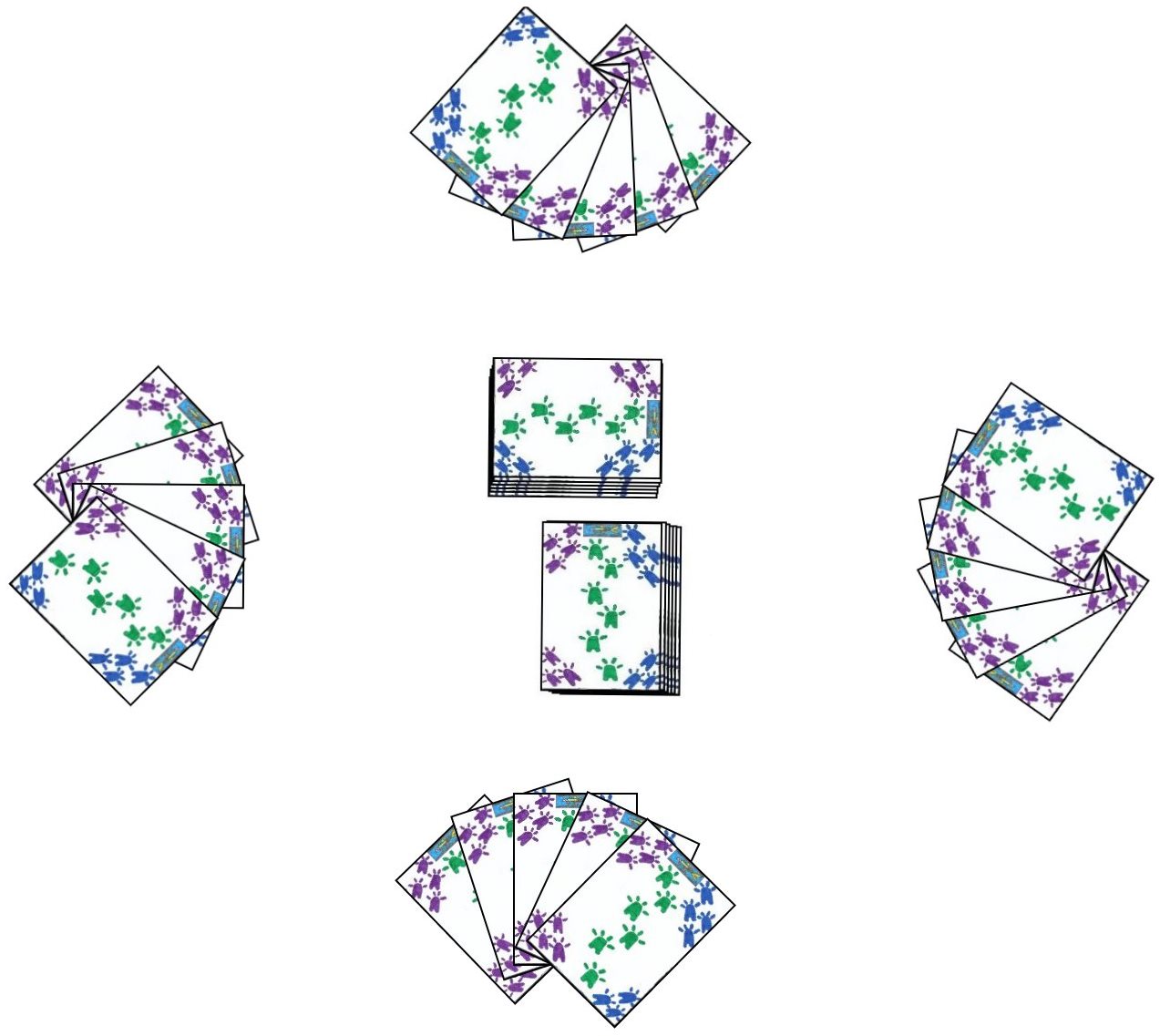The variant to be described is designed to be played by two to four players using one standard deck of cards. The ranking of the cards (primarily of importance in this game when a player attempts to create a straight type combination), are as follows, from high to low: King, Queen, Jack, 10, 9, 8, 7, 6, 5, 4, 3, 2, Ace. In addition, for scoring purposes and use in creating other combination types, each card in the deck has a relative point value as shown in the following chart:
| Card | Point Value |
|---|---|
| Ace | 1 |
| 2, 3, 4, 5, 6, 7, 8, 9, 10 | Point value marked on card |
| Jack, Queen, King | 10 |
The goal of the game is to complete the game having the highest total point score. This can be obtained for creating scoring combinations at the end of each of 12 rounds which comprises the game.
Determination of seating positions and first dealer can be determined using a number of different methods. The most popular is to have each player draw a card from the face-down shuffled deck. The player drawing the highest card has first choice of seats, the player drawing the next highest has the next choice and so on. If two or more players draw cards of the same ranking, these players put the cards aside and draw new cards. They would continue to draw additional cards until each player has a distinctly uniquely ranked card. The player who draws the highest card of all becomes the first dealer. After each round during the game, the deal passes to the next player in a clockwise rotation around the table.
 After the players are seated, the first dealer thoroughly shuffles the deck and offers the deck to the player at this right to cut. After the cut, the dealer then begins dealing from the deck, one card at a time in a clockwise direction around the table starting with the player to his immediate left. He continues this until each player has five face-down cards. The dealer then places the remainder of the deck in the center of the table as the stock. After this, the players then pick up and examine their hands. The player to the dealer's immediate left has the first turn.
After the players are seated, the first dealer thoroughly shuffles the deck and offers the deck to the player at this right to cut. After the cut, the dealer then begins dealing from the deck, one card at a time in a clockwise direction around the table starting with the player to his immediate left. He continues this until each player has five face-down cards. The dealer then places the remainder of the deck in the center of the table as the stock. After this, the players then pick up and examine their hands. The player to the dealer's immediate left has the first turn.
On each turn a player has several options, of which he must take one. If the player has created a scoring combination in his hand of which he has not yet scored for on this hand, he may choose to Knock. He does this by simply rapping on the table with his knuckles. A player who elects to knock may make no other plays on the turn and knocking ends the hand, with each other player (besides the knocker) getting one more turn in the usual turn order. A player may not knock on the same turn as he traded for any cards and must have a combination that will score at least one point on this hand before being permitted to knock.
If a player chooses not (or is unable) to knock on his turn, he must then draw from the stock or exchange cards. If he elects to draw from the stock, the player places from 1 to 5 cards face-up in front of himself in an area called his Harbor and then draws an equal number of cards from the stock into his hand to replace these discarded cards. This ends his turn.
Alternatively, the player may elect to exchange cards. If exchanging cards, he first discards the number of cards in front of himself (in his Harbor) as he opts to exchange. He then, from any one opponent, may take an equal number of cards from that player's face-up layout. He may only take cards from one player's layout in a turn and may never take cards back into his own hand from his own layout. Once discarded, those cards may no longer be used by that player unless another player first takes them and later discards them for any reason.
This usually continues for a number of rounds until at least one player has managed to create a scoring combination. The following shows the complete list of scoring combinations possible in this game.
| Combination Name | Description | Scoring | Example |
|---|---|---|---|
| Five Flush | Five cards in direct sequence, all of the same suit. The highest card allowable in a sequence is a King and the lowest is an Ace. | 100 |  |
| Sequence | Five cards in direct sequence, but not necessarily all of the same suit. The highest card allowable in a sequence is a King and the lowest an Ace. | 50 |  |
| Card Yacht | Four cards all of the exact same denomination (i.e. four fives or four Kings). The fifth card in the hand can be any other card. | 75 |  |
| Three and Two | Three cards all of the same denomination and two other cards, both of the same denomination. | 25 |  |
| High | Five cards in the hand which sum to exactly fifty. These cards may be of mixed suits. | 25 |  |
| Middle | Five cards in the hand which, when summed, total to exactly 25. These cards may be of any suits. | 50 |  |
| Low | Five cards in hand which total to 10 or less. These cards may be of any suits. | 50 |  |
| Flush | Five cards of any denomination, all of the same suit. | 25 |  |
| Spades (♠) | A hand which scores based on the denominations of all cards in the Spades suit found in the hand. | The player earns a score equal to the total sum of all the cards in the suit of Spades in the hand. |  |
| Hearts (♥) | A hand which scores based on the denominations of all cards in the suit of Hearts in the hand. | The total sum of all cards in the suit of Hearts in the hand. |  |
| Diamonds (♦) | A hand scoring based on the denominations of all cards in the Diamonds suit found in the hand. | The total sum of all cards in the hand of the suit of Diamonds. |  |
| Clubs (♣) | A hand that scores based on the denominations of all cards in the suit of Clubs in that player's hand. | The total sum of all cards in the suit of Clubs in that player's hand. |  |
Scoring and the Score Sheet: As mentioned previously, once any player has elected to knock as his turn, each other player (in the normal turn order starting with the player to the immediate left of the player who knocked), has one more turn to attempt to improve his hand. Once another player has knocked, a player may also elect to pass on his last turn. After each player has had his last turn, the players reveal their hands and scoring for the round occurs.
Since the game is played over exactly 12 rounds, each player must score in one category every turn. If a player does not fulfill the requirements for a certain category but elects to score in that category for this round, he scores zero for that category. Once a category has been scored in on a round (regardless of that score) he may not again score in that same category.
 After 12 rounds have been played, scoring for the game occurs to determine the winner. The players sum up the total from all 12 categories scored during the hand, with the player having the highest total declared the winner.
After 12 rounds have been played, scoring for the game occurs to determine the winner. The players sum up the total from all 12 categories scored during the hand, with the player having the highest total declared the winner.
Suited Bonus: It will also be noticed that the score sheet contains a special bonus category (Suited Bonus). If a player manages to score a total of 148 or more total points in the four suit categories (Spades, Hearts, Diamonds, Clubs) he is entitled to add an additional 100 points to his game total score.
If two or more players tie for the highest total points, the game is considered a tie amongst those players.
ScoreSheet: As mentioned above, this game requires a special scoresheet for convenience in recording the scores for each player. This scoresheet can easily be created on lined paper, by creating one horizontal row for each of the 12 combination scoring categories, as well as a row for the Suited Bonus and a grand total row. The sheet should also include one vertical column for each active player. The rows should be labeled with the score types and the columns labeled with the name of each participant in the game. A printable version of this scoresheet has been provided. Click this link for a printable version of a score-sheet which is designed to be used for the game.
 No Layout Card Yacht: Another version of Card Yacht is played similarly to the standard version as described above. The only changes to this variant vice the standard version as described at the top of the page are the following:
No Layout Card Yacht: Another version of Card Yacht is played similarly to the standard version as described above. The only changes to this variant vice the standard version as described at the top of the page are the following: